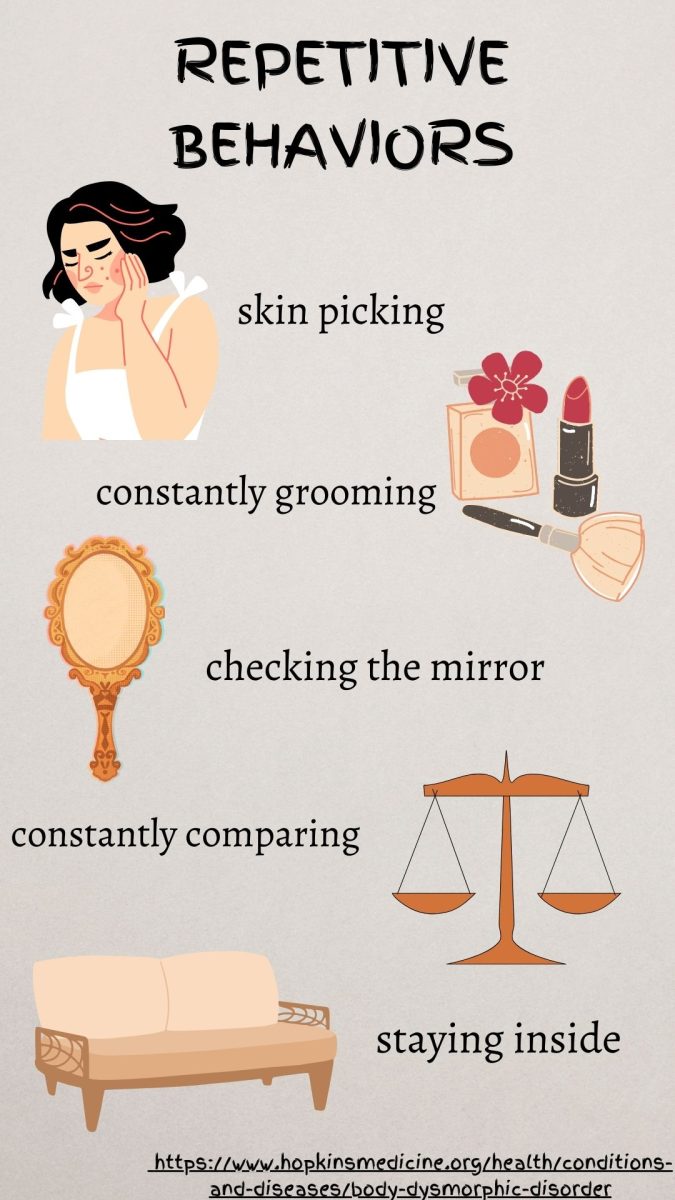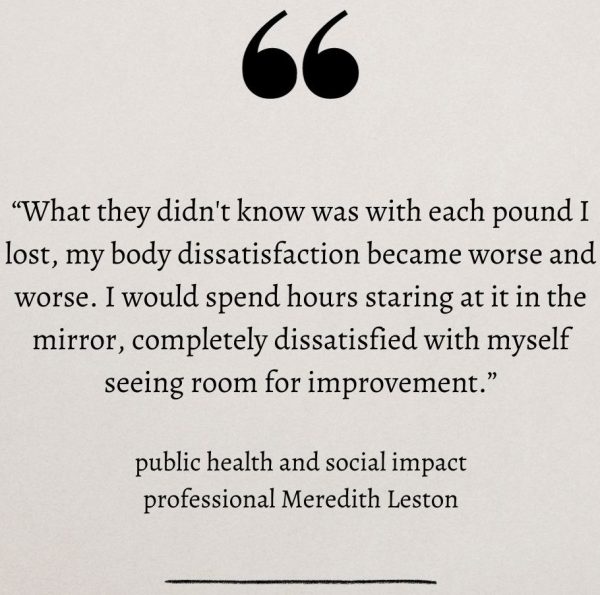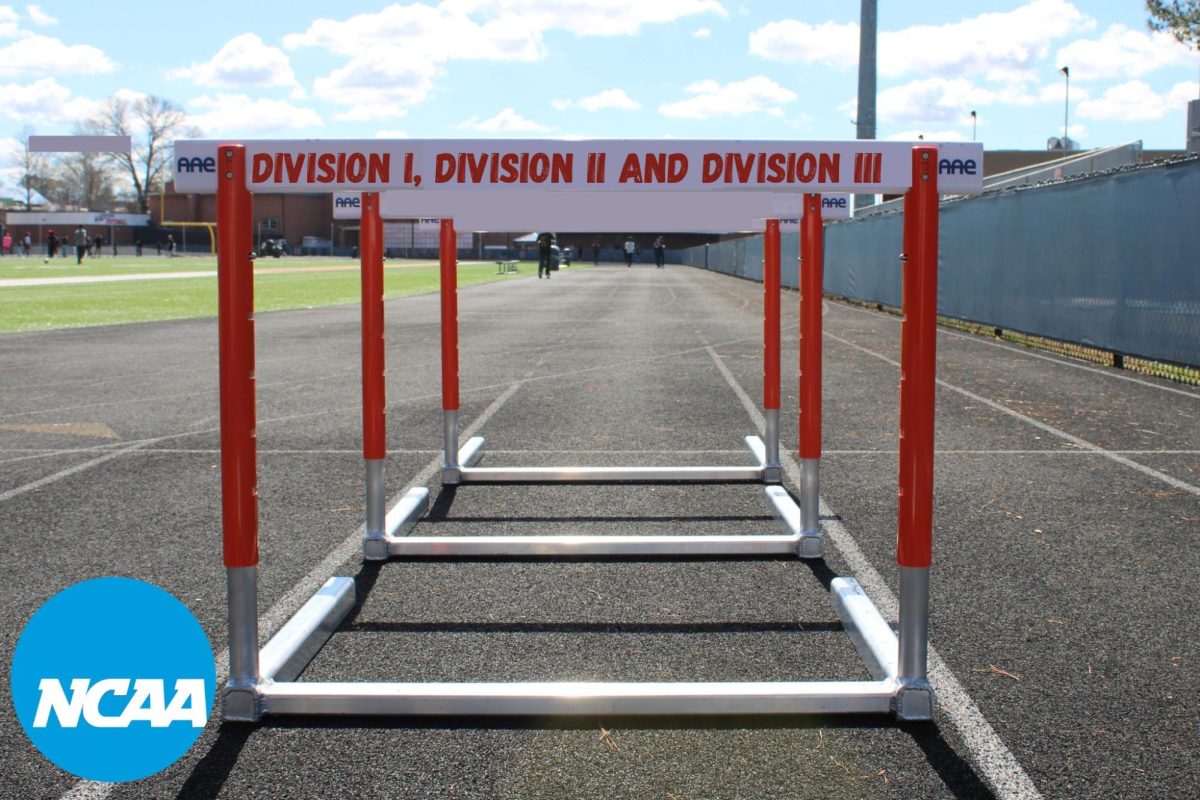For several teenagers, turning 13 represents parties and newfound freedom, but for 2.2% of young females and 2.5% of young males, their year 13 involves periods of starvation and hallucinations. Body dysmorphic disorder (BDD), a somatoform disorder that affects the way individuals view themselves, negatively affects multiple aspects of daily life. This disorder, separate from eating disorders, focuses on the self-deprecation and judgment of one’s body. The disorder relies particularly on observation, creating shameful thoughts over what one perceives their body to look like.
Found commonly in both male and female teenagers and young adults, this disorder frequently occurs behind closed doors. The struggle stems from imagined or exaggerated body defects that one feels insecure about, a feeling people typically do not publicly share. Widely unrecognized, these personal thoughts affect beyond what meets the eye. This disorder can reach public settings that several fail to consider. 
“I would say [someone who struggles with body dysmorphia] is someone who has drastically altered perceptions about their own body and their own weight and their own size. I think that they have distorted beliefs about nutrition and diet and exercise, and they go to extremes in all of those different areas. Those distorted beliefs about their size, their distorted beliefs about how much they should or should not eat, or how much they should or should not exercise,” AP Psychology teacher William Hargis said.
Weight, shape and details of appearance commonly become the motivators in BDD. Whether it ranges from a feature as undetectable as a slightly red blemish to thoughts of obesity, these thoughts of imperfection impact one’s actions regarding their body. Common symptoms include habitually skin picking, repeatedly checking mirrors and constantly seeking reassurance—all compulsive effects that bring stress and worry.
After the consistent, harsh judgment of one’s body, people with BDD feel they must solve the problem by changing their courses of eating. This adjustment in eating can morph into severe eating disorders such as bulimia nervosa and anorexia nervosa. These disorders cause periods of compulsive eating, intense starving or repetitive puking, and repeatedly stem from stress and negative thoughts. Another common habit directly related to eating disorders and BDD includes calorie counting: a repetitive cycle of totaling food consumption by number value. This can cause malnutrition and unhealthy dieting which can lead to one’s destructive health-related behaviors.
These behind-the-scenes thoughts can easily transfer to social settings where one may feel ashamed to stand in the presence of certain people, act a certain way or fear public rejection because of appearance. This can cause avoidance of public places and an urge to remain at home under all circumstances. Continuously staying inside with no exposure to the public causes people to lose touch with the outside world, making them feel down and depressed. When required to step outside the household, BDD-affected people tend to feel the need to cover up and avoid looking in mirrors due to stress.
Several people try to cure their BDD with plastic surgery, a style change and other similar methods, but no true cure exists. Since the problem occurs in the mind, only help such as therapy can truly make a change. Surgeries intended as cures routinely cause people to fall into a loop of treatments and a deeper rabbit hole of self-depreciation. As problems advance, so do attempts at fixing them, causing damaging effects on one’s body. Cosmetic surgeries stem from ideas of beauty standards and result in common procedures such as nose jobs, lip fillers and BOTOX.
BDD rarely makes an appearance in the media because of fear of judgment. Users in the online world face mass amounts of harsh criticism and hate that severely affects people with BDD. The symptoms of BDD may seem exaggerated and imagined to outsiders when it stands as a real condition that affects humans.
BDD frequently stems from sports, with athletes becoming the victims. Focuses on eating, health, physical appearance and fitness level can cause harmful ideas of body dysmorphia and can become normalized among athletes. Several sports require specific attire, which can cause athletes to feel uncomfortable in their bodies and looks, especially when in uniform. For example, numerous dancers wear leotards and tights and stand in front of a mirror for hours at a time. Constantly comparing and analyzing oneself causes harmful effects. Similarly, volleyball players likely receive the requirement to wear spandex shorts. These shorts hug the body, causing various people to feel insecure about what they look like wearing the shorts.
“Personally, I have been affected by body dysmorphia and I see many dancers going through it as well. As a dancer, we are forced to look at ourselves in the mirror in tight clothing for four-plus hours a day and it doesn’t help the way we view ourselves. Seeing other dancers and the younger generation start facing body dysmorphia breaks my heart. I want everyone to believe that they are beautiful and focus on self-care because as someone who has been affected, learning to love yourself is the most important thing,” junior Emily Ivers said.
Name-calling and mean comments cause insecurities at a young age that can stay as teens approach adulthood. After one seemingly insignificant comment surfaces, the person receiving the negative comment will constantly look for that one aspect about themselves. Then, it can become an insecurity that takes hold of an individual for the rest of their lives. This contributes to cyberbullying, another cause of disorders such as BDD and the various eating types.
Females generally become the victim of the hold of BDD, as they receive mass amounts of oppression in the media. Social comparison and cyberbullying can take place in online settings, causing harmful effects. Similarly, muscle dysmorphia frequently occurs in men, targeting thoughts of one’s build and physique. It encourages repetitive behaviors similar to those seen in BDD such as mirror-checking and depressive thoughts.
To become diagnosed with BDD, one must see a mental health provider or therapist. The diagnosis may help one cope and start treatment plans to eventually heal. Common treatments include cognitive behavioral therapy and medications, but different circumstances can create different outcomes for medical care.
“As Teddy Roosevelt said ‘comparison is the thief of joy,’ so what might be suitable for one person or somebody might be really happy with their self-esteem and perception of their body weight and size, could be totally unacceptable to someone who has body dysmorphia. It could be very detrimental to their health, their bones, their joints, they could cause premature arthritis, so very adverse effects on a daily level,” Hargis said.
As the holiday season approaches, these BDD struggles surface with the pressures of surrounding family and grouped eating settings. BDD creates discomfort in areas that should feel normal. As this prominent issue comes into the limelight, ways to cope with this disorder also improve.















